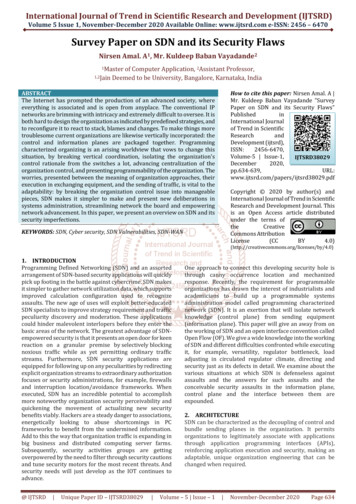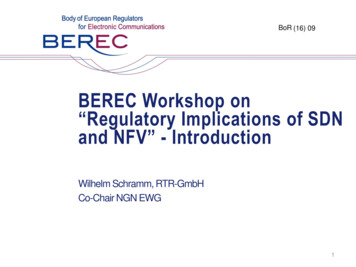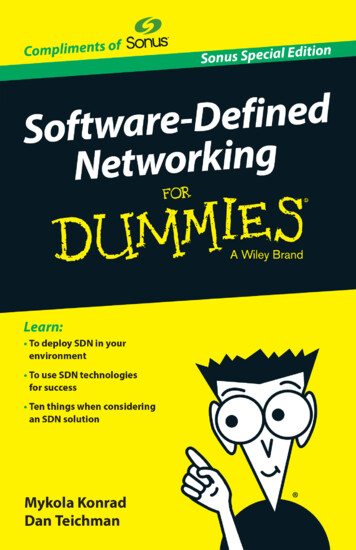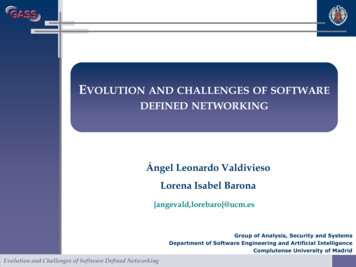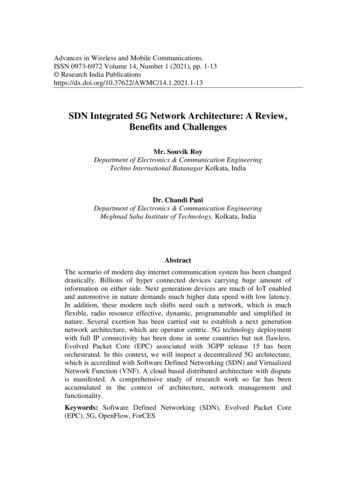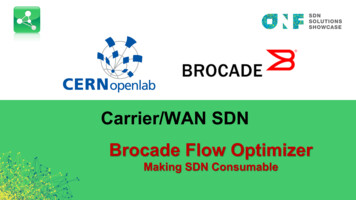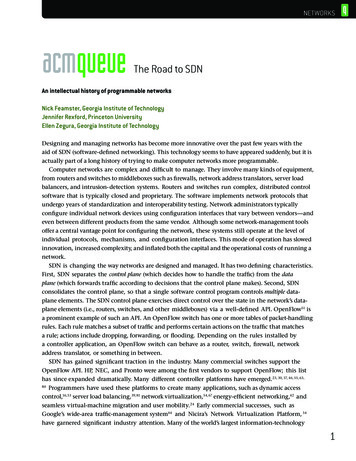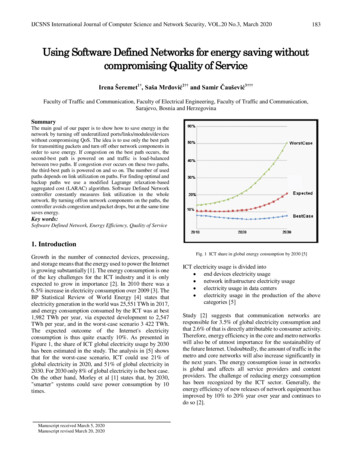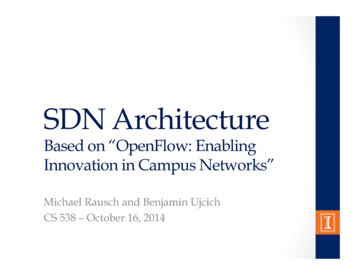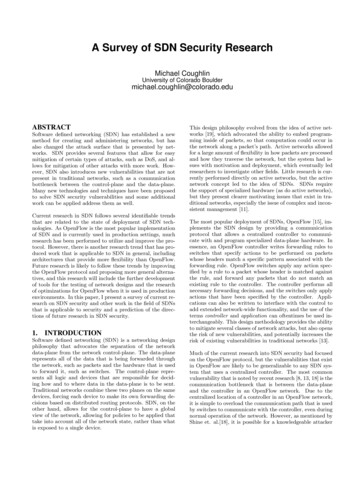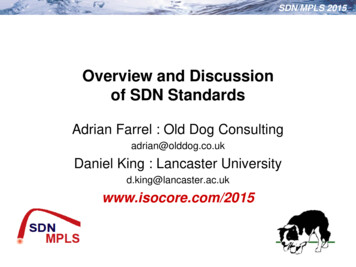
Transcription
SDN/MPLS 20152015SDN/MPLSOverview and Discussionof SDN StandardsAdrian Farrel : Old Dog Consultingadrian@olddog.co.ukDaniel King : Lancaster 15
SDN/MPLS 2015Reader Beware! This presentation makes no judgements We offer no attempt at guidance Which standards are best? Which standards body makes the most sense? Which protocols are best for which jobs? This is just a “catalogue” of the work in progress We deliberately blur the lines between SDN and NFV2
SDN/MPLS 2015Agenda Standards Development Organisations (SDO) working on SDN & NFV Focus on the IRTF & IETF Network Controllers Decomposition of the controller OpenSource Initiatives South Bound Interfaces ForCES, OpenFlow, BGP-LS, OVSDB, I2RS, PCEP, et al. North-Bound Interface Current activity and interest East West Interface What are the requirements?3
SDN/MPLS 2015SDN & NFV Standardisation Efforts Where is SDN & NFV specification and standardisationtaking place? What is the overlap with SDN deployment and research? Can we define the hot topics currently? What does industry think of these efforts? What are the main SDOs? How do they overlap and compete?Which are most complete?Which are easiest to participate in?Which are easiest to use?What does industry think of these efforts?
SDN/MPLS 2015“The nice thing about standards is there areso many to choose from.”“You wait for years for an SDO to work onyour technology and then ten come alongtogether.”5
SDN/MPLS 2015SDN & NFV Standardisation Efforts “SDN” Started with ONF, rapidly expanded to include: ITU-T, ETSI, IRTF/IETF, ATIS, BBF, CCSA, IEEE,TMF, CEF, MEF, TTA, and 3GPP Note that OpenSource efforts are in some sense defacto standardisation We will cover them later The volume and breadth of standards activity can bea barrier to participation Need to decide which organizations are important andwhere the opportunities are
SDN/MPLS 2015Open Networking Foundation The originators of all the current brouhaha Brought SDN to the attention of the world Developed and marketed OpenFlow as a South Boundinterface Also produced a comprehensive SDN architecture What are the hot areas within the ONF? North Bound InterfaceEast West InterfaceSecurityRelationship of SDN & NFV ArchitectureSDN Distribution: ATRIUM7
SDN/MPLS 2015ONF Atrium ONF provide an SDN distribution (Anchor Stack) “Atrium” is the first release to help simplify controller and applicationintegration 30 minutes from download to packet passing tutorials and process Build testbeds that operate with Anchor Stack First release of Anchor Stack (“Atrium”) BGP-Routing under Quagga as the Networking App ONOS as a controller (qv.) Prototype Pipeline Adaptation Layer OF-DPA 1.0 on Quanta LY4 Switch Corsa WAN Switches Dell ToR switches using non OF-DPA pipeline Supports 4 Different Vendor switches Already popular suppliers for OpenFlow hardware at different sizeand scale
SDN/MPLS 2015SDN & NFV Standardisation Efforts ITU-T Joint Coordination Activity on SDN (JCA) Will coordinate the work carried out by various ITU-T StudyGroups and Expert Groups Also acting as the first point of contact for organizations interestedin contributing to ITU’s SDN standardization program ITU-T Study Group 11 (Signalling requirements, protocolsand test specifications – telephone calls and data calls) Q.4 is developing a supplement (non-normative document) thatdescribes the framework of SDN signalling Q.6 is studying how to apply SDN technologies for IPv6
SDN/MPLS 2015SDN & NFV Standardisation Efforts ITU-T Study Group 13 (Future networks including cloudcomputing, mobile and NGN) Q.2 studies SDN and virtualization aspects for next generationnetworks (NGN) Q.14 is responsible of such framework and also discusses networkvirtualization, and has developed Recommendation ITU-T Y.3300(Framework of software-defined networking) ITU-T Study Group 15 (Transport, Access and Home) SG15 is studying “Transport aspects of SDN” It has commenced a new draft Recommendation “Architecture for SDN controlof Transport Networks”, aligned with the ONF’s “SDN architecture”, Issue 1, It has commenced a new draft Recommendation “Common Control Aspects”on common aspects of the interaction between the ASON control plane, SDNcontroller plane, management plane and transport plane
SDN/MPLS 2015SDN & NFV Standardisation Efforts ITU-T Study Group 16 (Multimedia) Q.3 is studying OpenFlow versus H.248 as a protocol to controlpacket flows Q.21 is studying virtual content delivery networks ITU-T Study Group 17 (Security) Q.6 is studying security by SDN, which covers the securityservices using SDN: Draft Recommendation ITU-T X.sdnsec-1 is developing requirements forsecurity services based on SDN Q.2 is studying security of SDN, which covers the securityarchitectural aspects of SDN and how to secure the SDNenvironment
SDN/MPLS 2015SDN & NFV Standardisation Efforts ETSI Industry Specification Groups (ISGs) for NetworkFunctions Virtualization (NFV ISG) ETSI is worldwide, not just European Dominated by operators not vendors NFV ISG set up to achieve a consistent approach and commonarchitecture for the hardware and software infrastructure needed tosupport virtualized network functions NFV ISG achieved first five deliverables : Four deliverables designed to align understanding about NFV across the industry,cover: NFV use cases, requirements, architectural framework and terminology Fifth deliverable defines a framework for coordinating and promoting publicdemonstrations of Proof of Concept (PoC) platforms illustrating key aspects of NFV,with the objective to encourage the development of an open ecosystem byintegrating components from different players NFV ISG created three more deliverables Methodology to describe interfaces and abstractions for NFV infrastructure Problem statement for NFV security and NFV performance Portability best practises
SDN/MPLS 2015ETSI NFV ISG Architectural Framework
SDN/MPLS 2015ETSI Management and Orchestration (MANO)Functional Components Management and Orchestration (MANO) Functional Blocks NFV Orchestrator: Network Service (NS) lifecycle management (including instantiation, scaleout/in, performance measurements, event correlation, termination) Global resource management, validation and authorization of NFVIresource requests Policy management for NS instances VNF Manager: Lifecycle management of VNF instances Overall coordination and adaptation role for configuration and eventreporting between NFVI and the E/NMS Virtualized Infrastructure Manager (VIM): Controlling and managing the NFVI compute, storage and networkresources, within one operator’s infrastructure sub-domain Collection and forwarding of performance measurements and events
SDN/MPLS 2015ETSI Management and Orchestration (MANO)Architecture
SDN/MPLS 2015ETSI NFV E2E Service
SDN/MPLS 2015SDN & NFV Standardisation Efforts MEF (No longer known as Metro Ethernet Forum) Is trying to address SDN/NFV and Cloud aspects thataffect Carrier Ethernet services 3rd Network (previously Network as a Service (NaaS))vision: Top down solution starting with Service Order at theOSS/BSS level, addressing service fulfilment andassurance for Carrier Ethernet which includes SDNorchestration solutions Started activity on service models for carrier Ethernetservices
SDN/MPLS 2015MEF’s Reference Architecture18
SDN/MPLS 2015SDN & NFV Standardisation Efforts CEF (Cloud Ethernet Forum) Mainly involved in Cloud related specifications Telecommunications Technology Association (TTA) Future Internet project group (PG220) is a lead project group of SDN issues relatedto ITU-T SG13PG220 is now developing TTA standards which describe common hardware andsoftware platforms to support open programmable networking and SDN/NFVenabled services 3GPP TSG SA WG5 (SA5) is a group for telecom managementStarted a new study item on Network Management of Virtualized NetworksTheir objective is to study the use cases concepts for the network management ofVirtualized Networks, to identify the requirements for potential solutions, and to dogap analysis between the identified requirements and current 3GPP Managementreference model
SDN/MPLS 2015SDN & NFV Standardisation Efforts IEEE P1903 WG (NGSON) Broadband Forum (BBF) The IEEE P1903 WG was setup to develop specifications for Next Generation ServiceOverlay Networks (NGSON)The P1903 WG is currently working on the specification of service enabling functionswhich can be provided as Virtualized Network Functions (VNFs) to support NFVapplications.Technical aspects which may be related to SDN are mechanisms for ServiceComposition, Service Routing and Self Organization aiming to provide service levelvirtualizationEnd to End Architecture (E2E) WGDiscusses end-to-end architecture issuesBusiness Requirements and Framework for SDN in Telecommunication BroadbandNetworksOperation of Residential Gateways and Business Gateways in association with SDNmodelTMF (No longer known as “TeleManagementForum”) Focused on adapting their management concepts interfaces and tools to support SDNand NFV
SDN/MPLS 2015SDN & NFV Standardisation Efforts China Communications Standards Association (CCSA) TC1 SWG3 This Special Working Group for FDN (future data network) hasdeveloped two standards: “Scenarios and requirements of FDN” “Function Architecture of FDN” TC3 WG1 This Working Group for SVN (Software Smart and virtualizedNetworking), mainly focuses on the standard activities on SDN-basedsmart network, network virtualization, and future network fromcarriers’ perspective. They developed two standards: “General Requirements for Network Intelligent Capability Enhancementmaking usage of software defined networking technologies (S-NICE)” “Research on VCN (Virtualization of Control Network-entity)”
SDN/MPLS 2015SDN & NFV Standardisation Efforts CCA (Cloud Clean Alliance) Established by Huawei to identify and coordinateagainst large DDoS attacks Facilitate near-source cloud mitigation to ensure linkavailability guarantees Obtain valuable data and trend analysis of the global DDoSattack status Provide “alliance” security service capabilities tocustomers Combination of specifications and hardware located in“scrubbing centers” across four continents
SDN/MPLS 2015SDN & NFV Standardisation Efforts Internet Research Task Force (IRTF)The research arm of the IETF SDN RG topics of interest More info on next slides NFV RG VNF Elasticity Policy Networks Machine Learning (NML) Network attack mitigation/DDOS Applicability of ML to complex path computation problems
SDN/MPLS 2015SDN Research Group : History Several attempts to bring SDN work into the IETF SDN Bar BoF at IETF 81 (July 2011) SDNP mailing list created Software Driven Networks BoF at IETF 82 (Nov, 2011) 400 participants “Enables network applications to request and manipulate servicesprovided by the network, and allow the network to providefeedback to the network applications.“ Not enough focus to form a working group IETF 84 (Jul, 2012) first meeting for a proposed SDN RG24
SDN/MPLS 2015IRTF: SDN Research Group Chartered Areas of interest include: architecture, solution scalability, abstractions, andprogramming languages and paradigmsThe explicit goal of the SDN RG is to provide a forum for researchers toinvestigate key and interesting problems in the SDN fieldClassification of SDN models, including SDN model scalability and applicabilityMulti-layer programmability and feedback control systemsSystem ComplexityNetwork description languages, abstractions, interfaces and compilers DefinitionsTaxonomiesRelationship to work ongoing in the IETF and other SDOsIncluding methods and mechanisms for (on-line) verification of correct operation ofnetwork/node function.Security25
SDN/MPLS 2015SDN RG Holds Focussed Meetings IETF 85 – Seeded some “SDN-hard” ProblemsIETF 86 – SDN Trends, Experiments and NFV first mentionedIETF 87 – Novel SDN Applications, Operator Perspectives, State Reductionand Dependable SDNsIETF 88 – Defining SDN in the context of the IETF, Architectures andTerminologyIETF 89 – SDN Hybrid Architectures and SDN Research in ActionIETF 90 – Hardware Abstraction, Modeling Languages and TrafficEngineeringIETF 91 – Scaling SDN, Blending SDN &NFV, NFV H-W Acceleration, andIoTIETF 92 – (Focused CFP) Inter-domain SDN, SDN in Mobile NetworksIETF 93 – (Focused CFP) SDN SecurityIETF 94 – (Focused CFP) Operator Research (Challenges, Findings andOpportunities), invited Japanese & Chinese researchers
SDN/MPLS 2015History of SDN in the IETF Working on SDN concepts for over 10 years GSMP ForCES PCE (for Packet and Optical) “SDN” Discussion started late 2011 IETF BoF 400 participants (operators, vendors, academics) Ended up boiling the SDN ocean Led to formation of SDN RG Seed ideas for new working groups in the IETF Establish requirements/use cases for extending existing IETFtechnologies Other pieces of the SDN puzzle continue to be worked on inIETF27
SDN/MPLS 2015IETF SDN Efforts Current Working Groups Path Computation Element - PCEInterface to the Routing System - I2RSLayer 3 Service Modeling– L3SMLayer Independent OAM Management in Multi-Layer – LIMESimplified Use of Policy Abstractions – SUPAInterface to network Security Functions – I2NSF Recent Working Group Initiatives Virtual Network Function Pools – VNF Pool Two BoF meetings, but was premature Abstraction and Control of Transport Networks – ACTN Moved into the TEAS working group28
SDN/MPLS 2015Standardisation Summary You would be hard pressed to follow all of the SDN standards activityin detail “Every organisation is potentially (and dangerously) self perpetuating” Few SDOs have a life-cycle plan that bound their authority and scope New technology study groups are exploding across multiple SDOs. Choose any new area of technical endeavour: Cloud, SDN, NFV, IoT,“APIs” and you will find ready examples This dilutes and confuses the effort for contributors and consumers Coordination across SDOs doesn’t really appear to be working Recall the purpose of standardisation To enable people to make interoperable implementations Diversity of standards does not aid interoperability It is no wonder that some people give up on standards and look toOpenSource29
SDN/MPLS 2015“If open APIs become the de-facto definition ofinteroperability requirements, the role of thestandardization bodies, and the opportunity foroperators to influence specifications, diminishes. As aresult the functional interoperability (andinterchangeability) of vendors and devices willdecrease, potentially leading to a more proprietary andless open and global nature of the wg-operators-ietf-0030
SDN/MPLS 2015Network Controllers Controller for Network Operations Decomposition of a Network Controller Application-Based Network Operations Optical Network Use Case & Requirements Open DaylightOPNFVONOSOpen Contrail31
SDN/MPLS 2015Controller for Network Operations “SDN Controller” is a contentious term: it can have many different meanings: Historically the term was derived from the network domain, technology and protocolmechanismSDN Controller wars are ongoing: Operators have an expectation of standards-based technologies for deploying andoperating networks SDN controller vendors rarely provide multivendor interoperability using openstandards Provisioning should be a compelling feature of SDN, however many SDNcontrollers use non-standardised APIs Recent Open Source initiatives are vendor ledTypically, SDN controllers have a very limited view of topology Multi-layer and multi-domain scenarios are slowly being addedFlexibility has been notably absent from most controller architectures both in terms ofsouthbound protocol support and northbound application requests32
SDN/MPLS 2015Decomposition of Network Controller Avoiding the mistake of a single “controller” architectureDiscovery of network resources and topology managementNetwork resource abstraction, and presentationRouting and path computationMulti-layer coordination and interworking Multi-domain & multi-vendor network resources provisioning through differentcontrol mechanisms (e.g., OpenFlow, ForCES)Policy ControlOAM and Performance MonitoringSecurity & ResiliencyA wide variety of southbound northbound protocol supportLeveraging existing technologies What is currently available? Must integrate with existing and developing standards. Decomposition33
SDN/MPLS 2015Application-Based Network Operations (ABNO) Application-Based Network Operation (ABNO) framework. “A PCE-based Architecture for Application-based NetworkOperations” https://tools.ietf.org/html/rfc7491 Old Dog Consulting, Juniper, Huawei, Telefonica, CTTC, NTT, ontrollerCloudBusinessOSSNMSABNOMetroNodeVendor AMetroNodeVendor BIPNodeVendor CIPNodeVendor DIPNodeVendor EOpticalNodeVendor ATransport (Optical/Packet)TransportNetwork Nodes34OpticalNodeVendor BOpticalNodeVendor C
SDN/MPLS 2015ABNOA PCE-enabled Network Controller PCE provides a set of tools for deterministic path computation Prior to PCE network operators might use complex planning tools to compute pathsand predict network behaviorPCE reduces the onerous network operation process of coordinating planning,computation, signaling and placement of path-based services PCE has evolved: Computes single and dependant LSPs in a stateless mannerConcurrent optimization of sets of LSPsPerforming P2P and P2MP path computationHierarchical PCE ArchitectureStateful computation and monitoring of LSPs The state in “stateful” is an LSP-DB Stored information about some or all LSPs in the network Active PCE, resize or recomputed based on BW or network triggersPCE-initiated LSP setup Delegate LSP control to the PCE Recommend rerouting of LSPs35
SDN/MPLS 2015ABNO Function Components “Standardized” components and co-operation.Policy ManagementNetwork Topology Path Computation andTraffic Engineering PCE, PCCStateful & StatelessOnline & OfflineP2P, P2MP, MP2MPMulti-layer Coordination LSP-DBTEDInventory ManagementVirtual Network Topology ManagerNetwork Signaling & Programming RSVP-TEPCEP, NETCONF, ForCES and OpenFlowInterface to the Routing System (I2RS)36
SDN/MPLS 2015Optical Network Complexity Flexible and Elastic Optical Networks Photonic Integrated Circuit (PIC) technology Paving the path towards cost effective transmission schemes beyond100Gbps.Digital Coherent and SuperChannel technology solutions Variable 100Gbps client signals and cost effective 100Gbps transponders Capable of long reach up to 400Gbps without regenerationCost effective and flexible transponders The Sliceable-Bandwidth Variable Transponder (SBVT). Reduce bandwidth to extend reach More spectrum to extend reach More bandwidth over short reach Flexi-grid A variable-sized optical frequency range.ITU-T Study Group 15 (www.itu.int/rec/T-REC-G.694.1)37
SDN/MPLS 2015Control of Today’s Optical Networks Current network operation is not adapted to flexible optical networking Multiple manual configuration actions are needed for network nodesNetwork solutions from different vendors typically use specific OSS/NMSimplementationsVery long provisioning timesLack of network bandwidth flexibility and inefficient use of inherent mbrella OSSNetwork OSSMetroOSSIP CoreOSSOpticalOSSNMSNMSNMSNMSNMSNMSNMSNMSVendor A Vendor B Vendor C Vendor D Vendor E Vendor A Vendor B Vendor NodeNodeNodeNodeNodeNodeNodeNodeVendor A Vendor A Vendor C Vendor C Vendor C Vendor B Vendor B Vendor B38
SDN/MPLS 2015Optical ControllerRequirements & Applications The network does not need to be seen any longer as a composition of individualelements Support of the next generation of variable and dynamic optical transport characteristics “Create a new transport connection for me”“Reoptimize my network after restoration switching”“Respond to how my network is being used”“Schedule these services”Leveraging existing technologies Multi-layer Path ProvisioningNetwork Optimization after RestorationAutomated deployment and operation of services. Applications need to be capable of interaction with the network.What is currently availableMust integrate with existing and developing standardsSupport for flexi-grid39
SDN/MPLS 2015Yes, but is it actually being used/developed? Publications & Standards EC-Funded Projects investigating, using and/or developing ABNO A PCE-Based Architecture for Application-Based Network Operations, IETF RFC7491Unanswered Questions in the Path Computation Element Architecture, IETF RFC7399“In-Operation Network Planning”, IEEE Communications Magazine“Adaptive Network Manager: Coordinating Operations in Flex-grid Networks”, ICTON (IEEE)“Experimental Demonstration of an Active Stateful PCE performing Elastic Operations and Hitless Defragmentation”,ECOC European Conference on Optical Communications“Planning Fixed to Flexgrid Gradual Migration: Drivers and Open Issues”, IEEE Communications Magazine“Dynamic Restoration in Multi-layer IP/MPLS-over-Flexgrid Networks”, IEEE Design of Reliable CommunicationNetworks (DRCN)“A Traffic Intensity Model for Flexgrid Optical Network Planning under Dynamic Traffic Operation”, OSA Optical FiberCommunication (OFC)XIFI, OFERTIE, DISCUS, CONTENT, PACEDeployments and Code Availability iONE, Universitat Politècnica de Catalunya (UPC) (OpenSource)ANM, Telefonica (OpenSource)Infinera (Closed Source)Ericsson (Closed Source)40
SDN/MPLS 2015OpenDaylight OpenDaylight is a Linux Foundation Collaborative Project which is structuredwith an open source project with a modular, pluggable, and flexible controllerplatform at its coreODL Basic Features Network Apps & Orchestration The top layer consists of business and network logic applications that controland monitor network behavior In addition, more complex solution orchestration applications needed for cloudand NFV thread services together and engineer network traffic in accordancewith the needs of those environments Controller Platform The middle layer is the framework in which the SDN abstractions can manifest,providing a set of common APIs to the application layer (commonly referred toas the northbound interface) while implementing one or more protocols forcommand and control of the physical hardware within the network (typicallyreferred to as the southbound interface) Physical & Virtual Network Devices The bottom layer consists of the physical & virtual devices, switches, routers,etc., that make up the connective fabric between all endpoints within thenetwork
SDN/MPLS 2015OpenDaylight – Framework (1/3) ODL Framework Overview The OpenDaylight Controller is a pure software and as a JVM it canbe run on any OS and Metal as long as it supports Java On the Southbound, ODL can support multiple protocols (as plugins),e.g., OpenFlow 1.0, OpenFlow 1.3, BGP-LS, etc. These modules are linked dynamically into a Service AbstractionLayer (SAL) The SAL exposes services to which the modules north of it are written The SAL figures out how to fulfill the requested service irrespective of theunderlying protocol used between the Controller and the network devices For the Controller to control devices in its domain it needs to knowabout the devices, their capabilities, reachability, etc. This information is stored and managed by the Topology Manager The other components like ARP handler, Host Tracker, DeviceManager and Switch Manager help in generating the topologydatabase for the Topology Manager
SDN/MPLS 2015OpenDaylight – Framework (2/3) The Controller exposes open Northbound APIs which are used byApplications ODL supports the OSGi framework and bidirectional REST for theNorthbound API OSGi framework is used for applications that will run in the sameaddress space as the Controller while the REST (web based) API isused for Apps that do not run in the same address space (or even thesame server) as the Controller The business logic and algorithms reside in the Apps These Apps use the Controller to gather network intelligence, runs itsalgorithm to do analytics and then use the Controller to orchestratethe new rules throughout the network The Controller has a built in GUI The GUI is implemented as an application using the sameNorthbound API as would be available for any other user application
SDN/MPLS 2015OpenDaylight – Framework (3/3) Switch Manager The Switch Manager API holds the details of the network element As a network element is discovered, its attributes (e.g. what switch/router it is, SWversion, capabilities, etc.) are stored in the data base by the Switch Manager GUI The GUI is implemented as an APP and uses the NB REST API to interactwith the other modules of the Controller This architecture thus ensures that whatever is possible with the GUI is alsoavailable via REST API and thus the Controller can be integrated easily into othermanagement or orchestration systems High Availability The OpenDaylight Controller supports a Cluster based High Availability model There are several instances of the OpenDaylight Controller which logically act asone logical controller This not only gives a fine grain redundancy but also allows a scale-out modelfor linear scalability To make the Controller highly available, resilience is added at: Controller level, by adding 1 or more controller instances in clustered fashion Make sure the Open Flow enabled switches (OF-S elements) are multi-homedto multiple instances of the controller Make sure the applications are multi-homed to the controller instances
SDN/MPLS 2015OpenDaylight – Hydrogen (1st Release)
SDN/MPLS 2015OpenDaylight – Helium (2nd Release)
SDN/MPLS 2015OpenDaylight – Lithium (3rd Release)
SDN/MPLS 2015OPNFV OPNFV Mission Open Platform for NFV (OPNFV) is relatively new Focused on accelerating the evolution of Network FunctionsVirtualization (NFV) Combines IT orchestration (OpenStack) with the SDN Controller(ONOS or ODL) OPNFV Initial Scope The initial scope of OPNFV will be on building NFV Infrastructure(NFVI), Virtualized Infrastructure Management (VIM), andincluding application programmable interfaces (APIs) to other NFVelements Blend candidate technologies for for Virtualized Network Functions(VNF) and Management and Network Orchestration (MANO)components OPNFV will work closely with ETSI’s NFV ISG
SDN/MPLS 2015OPNFV Focus Area
SDN/MPLS 2015ODL & OpenStack Integration OpenDaylight exposes a singlecommon OpenStack ServiceNorthbound API exposed matches Neutron APIprecisely Multiple implementations of Neutronnetworks in OpenDaylight OpenDaylight OpenStack NeutronPlugin simply passes through Simplifies OpenStack plugin pushes complexity to OpenDaylightOpenStack NeutronNeutron ML2MechanismDriverOpenDaylight APIs (REST)Neutron vider
SDN/MPLS 2015Open Networking Operating System (ONOS) Defining features of ONOS Distributed Core Provides scalability, high availability, and performance which brings carriergrade features to the SDN control plane Operator can add servers incrementally, without disruption, as needed foradditional control plane capacity Northbound abstraction/APIs Includes network graph and application intents to ease development of control,management, and configuration services There are two Northbound abstractions: the Intent Framework and the GlobalNetwork View Southbound abstraction/APIs Enables pluggable southbound protocols for controlling OpenFlow, NETCONFand Legacy devices Software Modularity Open Source with key vendor support (especially Huawei!)
SDN/MPLS 2015ONOS – High-level ArchitectureOther SBIs
SDN/MPLS 2015OpenContrail The Contrail System consists of two main components: The Contrail Controller: The Contrail Controller is a logically centralized but physically distributedSoftware Defined Networking (SDN) controller that is responsible for providingthe management, control, and analytics functions of the virtualized network The Contrail vRouter Contrail vRouter is a forwarding plane (of a distributed router) that runs in thehypervisor of a virtualized server It extends the network from the physical routers and switches in a datacenter into a virtual overlay network hosted in the virtualized servers The Contrail vRouter is conceptually similar to existing commercial andopen source vSwitches such as for example the Open vSwitch (OVS) butit also provides routing and higher layer services (hence vRouter insteadof vSwitch). The Contrail Controller provides the logically centralized control plane andmanagement plane of the system and orchestrates the vRouters
SDN/MPLS 2015OpenContrail Architecture
SDN/MPLS 2015SDN Controllers : Summary There are a number of proposed architectures There are also several Open Source implementation The architectures are relatively similar Modular APIs between components Allows pluggable components Northbound and southbound interfaces In some way “standardised”55
SDN/MPLS 2015South Bound Interfaces A plethora of protocols may be used in the SDN environment The non-exhaustive list below shows standards-based protocols beingused in the telecom market. OpenFlow Forwarding and Control Element Separation (ForCES) Path Computation Element (PCEP) Extensible Messaging and Presence Protocol (XMPP) Border Gateway Protocol Linkstate Distribution (BGP-LS) NETCONF/RESTCONF with YANG/JSON Interface to the Routing System (I2RS) Ope
It has commenced a new draft Recommendation "Architecture for SDN control of Transport Networks", aligned with the ONF's "SDN architecture", Issue 1, It has commenced a new draft Recommendation "Common Control Aspects" on common aspects of the interaction between the ASON control plane, SDN
